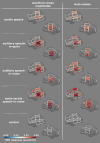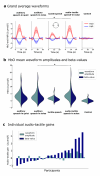Vibrotactile speech cues are associated with enhanced auditory processing in middle and superior temporal gyri
- PMID: 40652017
- PMCID: PMC12255685
- DOI: 10.1038/s41598-025-07718-8
Vibrotactile speech cues are associated with enhanced auditory processing in middle and superior temporal gyri
Abstract
Combined auditory and tactile stimuli have been found to enhance speech-in-noise perception both in individuals with normal hearing and in those with hearing loss. While behavioral benefits of audio-tactile enhancements in speech understanding have been repeatedly demonstrated, the impact of vibrotactile cues on cortical auditory speech processing remains unknown. Using functional near-infrared spectroscopy (fNIRS) with a dense montage setup, we first identified a region-of-interest highly sensitive to auditory-only speech-in-quiet. In the same region, we then assessed the change in activity ('audio-tactile gains') when presenting speech-in-noise together with a single-channel vibratory signal to the fingertip, congruent with the speech envelope's rate of change. In data from 21 participants with normal hearing, audio-tactile speech elicited on average 20% greater hemodynamic oxygenation changes than auditory-only speech-in-noise within bilateral middle and superior temporal gyri. However, audio-tactile gains did not exceed the sum of the unisensory responses, providing no conclusive evidence of true multisensory integration. Our results support a metamodal theory for the processing of temporal speech features in the middle and superior temporal gyri, providing the first evidence of audio-tactile speech processing in auditory areas using fNIRS. Top-down modulations from somatosensory areas or attention networks likely contributed to the observed audio-tactile gains through temporal entrainment with the speech envelope's rate of change. Further research is needed to understand the neural responses in concordance with their behavioral relevance for speech perception, offering future directions for developing tactile aids for individuals with hearing impairments.
Keywords: Audio-tactile perception; Auditory processing; Functional near-infrared spectroscopy; Multimodal speech; Multisensory processing.
© 2025. The Author(s).
Conflict of interest statement
Declarations. Competing interests: The authors declare no competing interests.
Figures





Similar articles
-
Short-Term Memory Impairment.2024 Jun 8. In: StatPearls [Internet]. Treasure Island (FL): StatPearls Publishing; 2025 Jan–. 2024 Jun 8. In: StatPearls [Internet]. Treasure Island (FL): StatPearls Publishing; 2025 Jan–. PMID: 31424720 Free Books & Documents.
-
Sound Level Changes the Auditory Cortical Activation Detected with Functional Near-Infrared Spectroscopy.Brain Topogr. 2023 Sep;36(5):686-697. doi: 10.1007/s10548-023-00981-w. Epub 2023 Jul 1. Brain Topogr. 2023. PMID: 37393418 Free PMC article.
-
Processing of Visual Speech Cues in Speech-in-Noise Comprehension Depends on Working Memory Capacity and Enhances Neural Speech Tracking in Older Adults With Hearing Impairment.Trends Hear. 2024 Jan-Dec;28:23312165241287622. doi: 10.1177/23312165241287622. Trends Hear. 2024. PMID: 39444375 Free PMC article.
-
Hearing Instruments for Unilateral Severe-to-Profound Sensorineural Hearing Loss in Adults: A Systematic Review and Meta-Analysis.Ear Hear. 2016 Sep-Oct;37(5):495-507. doi: 10.1097/AUD.0000000000000313. Ear Hear. 2016. PMID: 27232073 Free PMC article.
-
The effectiveness and cost-effectiveness of cochlear implants for severe to profound deafness in children and adults: a systematic review and economic model.Health Technol Assess. 2009 Sep;13(44):1-330. doi: 10.3310/hta13440. Health Technol Assess. 2009. PMID: 19799825
References
-
- Sumby, W. H. & Pollack, I. Visual contribution to speech intelligibility in noise. J. Acoust. Soc. Am.26, 212–215 (1954).
-
- Grant, K. W. & Seitz, P.-F. The use of visible speech cues for improving auditory detection of spoken sentences. J. Acoust. Soc. Am.108, 1197–1208 (2000). - PubMed
-
- Erber, N. P. Auditory-visual perception of speech. J. Speech Hear. Disord.40, 481–492 (1975). - PubMed
MeSH terms
LinkOut - more resources
Full Text Sources

